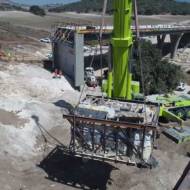
Complex Rescue Mission Extracts 2,000-Year-Old Ritual Bath from Biblical-Era Farmstead

This ancient stone mikveh from the Second Temple period was carved out of the site and moved to a nearby kibbutz to be preserved.
By Yakir Benzion, United With Israel
It’s a well known fact that when the bulldozers go out in Israel to start a new construction project, they are accompanied by archaeologists because excavations frequently reveal ancient treasures and artifacts that need to be preserved.
That was the case when construction of a new highway in northern Israel uncovered an ancient Jewish farmstead including a 2,000-year-old mikveh, or ritual bath, that was rescued in a highly unlikely archaeological salvage excavations by the Israel Antiquities Authority (IAA) and transferred Wednesday to its new home next to a modern-day mikveh at nearby Kibbutz Hannaton.
IAA officials said the discovery of the ritual bath provided evidence for the first time that Jewish farmsteads existed in the Galilee area during the Second Temple Period
Local residents from the village of Kfar Manda, students from pre-military preparatory programs, kibbutz residents and others from the area all volunteered to help with the excavations.
“The existence of a mikveh, a purification facility, unequivocally indicates that the residents of the ancient farm were Jewish, who led a religious and traditional way of life, and maintained purity as a Torah commandment. Ritual baths have been used in daily life by Jews since the Second Temple period and until today,” said excavation director Abd Elghani Ibrahim,
“The discovery of the mikveh in the farmstead changes what we knew about the lifestyle of the Jews in the Second Temple period. Until now we hadn’t discovered Jewish farms in the Galilee. It was considered that the Jews in the Roman period didn’t live in farms outside the villages or towns,” said archaeologist Dr. Walid Atrash.
About seventeen hundred years have passed since the farm was destroyed in an earthquake, and about fourteen hundred years since the site was finally abandoned.
When construction of a new highway interchange started, anchors for the supporting bridge columns necessitated deep foundation trenches and as the archaeologists excavated next to the construction area, the mikveh was uncovered.
Because the highway construction made it impossible to preserve the mikveh on the site, it was decided to cut the entire edifice out from the bedrock and to transplant it to a protected site for display, for the benefit of the public.
Members of Kibbutz Hannaton launched a crowd-funding campaign for the project, with the aim of placing the ancient mikveh next to the functioning mikveh on the kibbutz.
After additional funding was found, the massive 57 ton hunk of carved rock was first sawed off on all sides, detached from the bedrock and surrounded by a steel cage in order to protect it and allow it to be hoisted.
On Wednesday, to the cheers of the residents, it was hoisted in the air and placed in its new home.
HELP ISRAELIS BATTLE CORONA!
Donate to the Corona Emergency Relief Fund. Coronavirus has taken a huge toll on the people of Israel. The poor, elderly and ill are most vulnerable.
Israeli soldiers, security officers and medical care providers operate under great danger and risk to life.
Over 1 million Israelis are out of work. Many cannot make ends meet. We provide financial aid, food, medical supplies and more. Funds are distributed where needed most. The time to act is now!
United with Israel